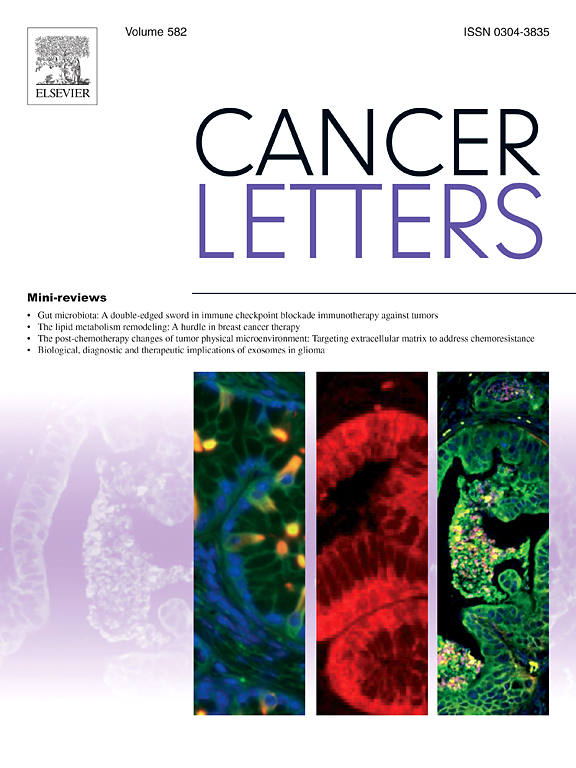Enhanced mitochondrial biogenesis facilitates the development of cutaneous squamous cell carcinoma
IF 9.1
1区 医学
Q1 ONCOLOGY
引用次数: 0
Abstract
Mitochondrial malfunction is traditionally viewed as a major factor in tumor growth and malignancy, while recent studies have introduced conflicting views suggesting the necessity of functional mitochondria for tumor growth. Despite these differing perspectives, the specific role of mitochondria in cutaneous squamous cell carcinoma (cSCC) remains poorly understood. In this study, we observed increased mitochondrial abundance and function during the development of cSCC. We also identified retinoic acid receptor response 1 (RARRES1), which is dramatically decreased in human cSCC samples, as a key regulator of mitochondrial homeostasis. Mechanistically, RARRES1 can translocate into mitochondria and facilitate the degradation of TFAM by binding to LONP1, thereby regulating mitochondrial biogenesis. While RARRES1 suppression unleashed TFAM to promote mitochondrial biogenesis, leading to the progression of cSCC. Targeting RARRES1-LONP1/TFAM axis shows significant potential for inhibiting cSCC development. This study reveals a unique network for regulating mitochondrial homeostasis and emphasizes the crucial role of mitochondria in cSCC development, positioning the RARRES1-LONP1/TFAM axis as promising therapeutic target for future clinical applications.
线粒体生物发生的增强促进了皮肤鳞状细胞癌的发展。
线粒体功能障碍传统上被认为是肿瘤生长和恶性肿瘤的主要因素,而最近的研究提出了相互矛盾的观点,表明功能性线粒体对肿瘤生长的必要性。尽管有这些不同的观点,线粒体在皮肤鳞状细胞癌(cSCC)中的具体作用仍然知之甚少。在这项研究中,我们观察到在cSCC的发展过程中线粒体丰度和功能增加。我们还发现视黄酸受体反应1 (RARRES1)在人类cSCC样本中显著降低,是线粒体稳态的关键调节因子。机制上,RARRES1可以通过与LONP1结合转运到线粒体,促进TFAM的降解,从而调节线粒体的生物发生。而RARRES1抑制释放TFAM促进线粒体生物发生,导致cSCC的进展。靶向RARRES1-LONP1/TFAM轴显示出抑制cSCC发展的巨大潜力。这项研究揭示了一个独特的调节线粒体稳态的网络,并强调了线粒体在cSCC发展中的关键作用,将RARRES1-LONP1/TFAM轴定位为未来临床应用的有希望的治疗靶点。
本文章由计算机程序翻译,如有差异,请以英文原文为准。
求助全文
约1分钟内获得全文
求助全文
来源期刊

Cancer letters
医学-肿瘤学
CiteScore
17.70
自引率
2.10%
发文量
427
审稿时长
15 days
期刊介绍:
Cancer Letters is a reputable international journal that serves as a platform for significant and original contributions in cancer research. The journal welcomes both full-length articles and Mini Reviews in the wide-ranging field of basic and translational oncology. Furthermore, it frequently presents Special Issues that shed light on current and topical areas in cancer research.
Cancer Letters is highly interested in various fundamental aspects that can cater to a diverse readership. These areas include the molecular genetics and cell biology of cancer, radiation biology, molecular pathology, hormones and cancer, viral oncology, metastasis, and chemoprevention. The journal actively focuses on experimental therapeutics, particularly the advancement of targeted therapies for personalized cancer medicine, such as metronomic chemotherapy.
By publishing groundbreaking research and promoting advancements in cancer treatments, Cancer Letters aims to actively contribute to the fight against cancer and the improvement of patient outcomes.
 求助内容:
求助内容: 应助结果提醒方式:
应助结果提醒方式:


